Chapter 17
Heat and Work: The Laws of Thermodynamics
In This Chapter
 Achieving thermal equilibrium
Achieving thermal equilibrium
 Storing heat and energy under different conditions
Storing heat and energy under different conditions
 Revving up heat engines for efficiency
Revving up heat engines for efficiency
 Dropping close to absolute zero
Dropping close to absolute zero
If you’ve ever had an outdoor summer job, you know all about heat and work, a relationship encompassed by the term thermodynamics. This chapter brings together those two cherished topics, which I cover in detail in Chapter 9 (work) and Chapter 14 (heat).
Thermodynamics has laws one through three, much like Newton, but it does Newton one better: Thermodynamics also has a zeroth law. You may think that odd, because few other sets of everyday objects start off that way (“Watch out for that zeroth step — it’s a doozy . . .”), but you know how physicists love their traditions.
In this chapter, I cover thermal equilibrium (the zeroth law), heat and energy conservation (the first law), heat flow (the second law), and absolute zero (the third law). Time to throw the book at thermodynamics.
Thermal Equilibrium: Getting Temperature with the Zeroth Law
Two objects are in thermal equilibrium if heat can pass between them but no heat is actually doing so. For example, if you and the swimming pool you’re in are at the same temperature, no heat is flowing from you to it or from it to you (although the possibility is there). You’re in thermal equilibrium. On the other hand, if you jump into the pool in winter, cracking through the ice covering, you won’t be in thermal equilibrium with the water. And you don’t want to be. (Don’t try this physics experiment at home!)
To check for thermal equilibrium (especially in cases of frozen swimming pools that you’re about to jump into), you should use a thermometer. You can check the temperature of the pool with the thermometer and then check your temperature. If the two temperatures agree — in other words, if you’re in thermal equilibrium with the thermometer, and the thermometer is in thermal equilibrium with the pool — you’re in thermal equilibrium with the pool.
Among other jobs, the zeroth law sets up the idea of temperature as an indicator of thermal equilibrium. The two objects mentioned in the zeroth law are in equilibrium with a third, giving you what you need to set up a scale such as the Kelvin scale.
Conserving Energy: The First Law of Thermodynamics
The first law of thermodynamics deals with energy conservation. One of the forms of energy involved is the internal energy that resides in the motion of the atoms and molecules (vibrations and random jostling). Another of the terms in this law is heat, which is a transfer of thermal energy. And finally, there is work, which is a transfer of mechanical energy; for example, work is done on a gas when it is compressed. The first law of thermodynamics states that these energies, together, are conserved. The initial internal energy in a system, Ui, changes to a final internal energy, Uf, when heat, Q, is absorbed or released by the system and the system does work, W, on its surroundings (or the surroundings do work on the system), such that
Uf – Ui = ΔU = Q – W
For mechanical energy to be conserved (see Chapter 9), you have to work with systems where no energy is lost to heat — there could be no friction, for example. All that changes now. Now you can break down the total energy of a system, which includes heat, work, and the internal energy of the system.
These three quantities — heat, work, and internal energy — make up all the energy you need to consider. When you add heat, Q, to a system, and that system doesn’t do work, the amount of internal energy in the system, which is given by the symbol U, changes by Q. A system can also lose energy by doing work on its surroundings, such as when an engine lifts weight at the end of a cable. When a system does work on its surroundings and gives off no waste heat, its internal energy, U, changes by W. In other words, you’re in a position to think in terms of heat as energy, so when you take into account all three quantities — heat, work, and the internal energy — energy is conserved.
The first law of thermodynamics is a powerful one because it ties all the quantities together. If you know two of them, you can find the third.
Calculating with conservation of energy
The most confusing part about using ΔU = Q – W is figuring out which signs to use. The quantity Q (heat transfer) is positive when the system absorbs heat and negative when the system releases heat. The quantity W (work) is positive when the system does work on its surroundings and negative when the surroundings do work on the system.
 The system absorbs heat: Q > 0
The system absorbs heat: Q > 0
 The system releases heat: Q < 0
The system releases heat: Q < 0
 The system does work on the surroundings: W > 0.
The system does work on the surroundings: W > 0.
 The surroundings do work on the system: W < 0.
The surroundings do work on the system: W < 0.
Practicing the sign conventions
Say that a motor does 2,000 joules of work on its surroundings while releasing 3,000 joules of heat. By how much does its internal energy change? In this case, you know that the motor does 2,000 joules of work on its surroundings, so its internal energy (U) will decrease by 2,000 joules. And the system also releases 3,000 joules of heat while doing its work, so the internal energy of the system decreases by an additional 3,000 joules. Thinking this way makes the total change of internal energy the following:
ΔU = –2,000 J – 3,000 J = –5,000 J
The internal energy of the system decreases by 5,000 joules, which makes sense. On the other hand, what if the system absorbs 3,000 joules of heat from the surroundings while doing 2,000 joules of work on those surroundings? In this case, you have 3,000 joules of energy going in and 2,000 joules going out. The signs are now easy to understand:
ΔU = –2,000 J [work going out] + 3,000 J [heat coming in] = 1,000 J
In this case, the net change to the system’s internal energy is +1,000 joules.
You can also see negative work when the surroundings do work on the system. Say, for example, that a system absorbs 3,000 joules at the same time that its surroundings perform 4,000 joules of work on the system. You can tell that both of these energies will flow into the system, so the system’s internal energy goes up by 3,000 J + 4,000 J = 7,000 J. If you want to go by the numbers, use this equation:
ΔU = Q – W
Then note that because the surroundings are doing work on the system, W is considered negative. Therefore, you get the following equation:
ΔU = Q – W = +3,000 J – (–4,000 J) = 7,000 J
Say that the system absorbs 1,600 joules of heat from the surroundings and performs 2,300 joules of work on the surroundings. What is the change in the system’s internal energy? Use the equation ΔU = Q – W. Here, Q is positive, because energy is absorbed by the system, and work is also positive, because work is done by the system, so you have
ΔU = Q – W = +1,600 J – (+2,300 J) = 700 J
So the internal energy of the system decreases by 700 joules.
Now say that the system absorbs 1,600 joules of heat while the surroundings do 2,300 joules of work on the system. What’s the change in the internal energy of the system?
In this case, the work done by the system is negative — that is, the surroundings do work on the system. So using ΔU = Q – W, you do the following calculations:
ΔU = Q – W
= +1,600 J – (–2,300 J)
= +1,600 J + 2,300 J
= 3,900 J
So in this case, where the system both absorbs heat and work is done on it, the change in internal energy is 3,900 joules.
Trying a first-law-of-thermodynamics sample problem
The president of Acme Gas comes up to you, the world-famous physicist. “Our gases are getting lazy,” the president says. “We have two processes, and we need to select the process where the gas does the most work for us. In both methods, the temperature of 6.0 moles of ideal gas is reduced from 590 kelvins to 400 kelvins. In method one, 5,500 joules of heat flow into the gas, while in method two, 1,500 joules of heat flow into the gas. So in which method does the gas do more work?”
Hmm, you think. Now’s the time to use the equation ΔU = Q – W. You want to find the work, so you solve for the work done by the gas:
W = Q – ΔU
You know how much heat, Q, flows into the gas in each method because the president just told you those numbers. But what about the change in internal energy of the gas? You know that the internal kinetic energy of an ideal gas is the following (taking a tip from Chapter 16):

And because the gas is ideal, the molecules don’t interact with one another, so the gas has no potential energy; therefore, the total internal energy of the gas is simply the kinetic energy:

That means that the internal energy of an ideal gas depends only on its temperature. Because the gas ends up with the same temperature change in both methods Acme Gas uses, the change of the internal energy of the gas will be the same in both cases.
In particular, the change in the internal energy of the gas in both methods is

So because the ideal gas drops in temperature, the internal energy of the gas is reduced — in this case, by 14,200 joules.
Now you can plug the value of ΔU into the work equations for the ideal gas in both methods:
W = Q – (–14,200 J)
In method one, the gas absorbs 5,500 joules, so you have
W1 = 5,500 J – (–14,200 J) = 19,700 J
And for the second method, the gas absorbs 1,500 joules, so here’s how much work the gas does:
W2 = 1,500 J – (–14,200 J) = 15,700 J
“In method one,” you tell the president of Acme Gas, “the gas does 19,700 joules of work. In method two, the gas only does 15,700 joules of work.”
“We’ll use method one, then,” says the president. “And stop those gases from getting lazy!”
Staying constant: Isobaric, isochoric, isothermal, and adiabatic processes
You come across a number of quantities in this chapter — volume, pressure, temperature, and so on. The ways in which these quantities vary as work is done determine the final state of the system. For example, if a gas is doing work while you keep its temperature constant, the amount of work performed and the intermediate and final states of the system will be different from when you keep the gas’s pressure constant instead.
W = Fs
In turn, force equals pressure, P, times area, A (see Chapter 8). This means that you can write work as pressure times area times distance:
W = PAs
Finally, the area times the distance (As) equals the change in volume, ΔV, so here’s the new work equation:
W = PΔV
In this section, I cover four standard conditions under which work is performed in thermodynamics: constant pressure, constant volume, constant temperature, and constant heat. I also graph pressure and volume for each of these processes and show you what work looks like. Note: When anything changes in these processes, the change is assumed to be quasi-static, which means the change comes slowly enough that the pressure and temperature are the same throughout the system’s volume.
At constant pressure: Isobaric
When you have a process where the pressure stays constant, it’s called isobaric (baric means “pressure”). In Figure 17-1, you see a cylinder with a piston being lifted by a quantity of gas as the gas gets hotter. The volume of the gas is changing, but the weighted piston keeps the pressure constant.
Figure 17-1: An isobaric system may feature a change in volume, but the pressure remains constant.
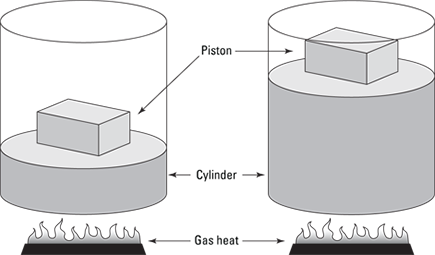
Graphically, you can see what the isobaric process looks like in Figure 17-2, where the volume is changing while the pressure stays constant. Because W = PΔV, the work is the shaded area beneath the graph.
Figure 17-2: Pressure and volume in an isobaric system.
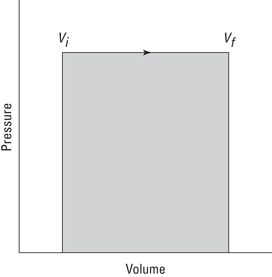
Say you have 60 cubic meters of an ideal gas at a pressure of 200 pascals. You heat the gas until it expands to a volume of 120 cubic meters (see Chapter 14 for details on gas expansion as temperature rises). How much work does the gas do? All you have to do is plug in the numbers:
W = PΔV = (200 Pa)(120 m3 – 60 m3) = 12,000 J
The gas does 12,000 joules of work as it expands under constant pressure.
Working with constant water pressure
Suppose you’re waiting for a connecting flight to the next physics conference. You look around but don’t see much to amuse yourself with — just a water fountain. Proving that physicists can find fun anywhere, you take a gram of water from the fountain and put it into the pocket isobaric chamber that you always happen to carry with you. As an airport security guard looks on, you increase the pressure to 2.0 × 105 pascals and increase the temperature of the water by 62°C.
You note that the gram of water increases in volume by 1.0 × 10–8 cubic meters. “Hmm,” you think. “I wonder what work was done by the water and what the change in internal energy of the water was.” The process was isobaric, so the work done by the water was
W = PΔV
Filling in the numbers and doing the math yields:
W = (2.0 × 105 Pa)(1.0 × 10–8 m3) = 0.002 J
So that’s the work done by the water. What about the change in the internal energy of the water? The first law of thermodynamics tells you that
ΔU = Q – W
You know W, but what is Q? Q is the heat absorbed by the water. You know the change in temperature of the water, and using the water’s specific heat capacity (Chapter 15), you can find the heat actually absorbed by the water using this equation:
Q = cmΔT
Water’s specific heat capacity is 4,186 J/kg·°C. Plugging in the numbers and doing the math gives you
Q = cmΔT = (4,186 J/kg·°C)(0.0010 kg)(62°C) ≈ 260 J
Now back to the first law of thermodynamics:
ΔU = Q – W
Substituting in the values gives you the change in internal energy:
ΔU = Q – W = 260 J – 0.002 J ≈ 260 J
Hmm, you think. The work done was a tiny 0.002 joules, while the change in internal energy was 260 joules. Interesting — very little work was done because the water didn’t expand much, but you saw a fair gain in internal energy because the water’s temperature went up.
Increasing steam’s energy without changing the pressure
Now you decide to find the work done by something that can really expand, such as steam. Would the work done change by a lot? You decide to take a look.
Using your isobaric chamber, you raise the temperature of a gram of water until it becomes steam. Then you raise the temperature of the steam by 62°C (just as you raise the temperature of the liquid water by the same amount in the preceding section) while keeping the pressure at 2.0 × 105 pascals. This time, you note that the steam expanded by a lot more than the liquid water did — by 7.1 × 10–5 cubic meters.
How much work did the steam do? Because the expansion was in your pocket isobaric chamber, the process didn’t involve a change in pressure, so you can use the following equation:
W = PΔV
Substituting in the numbers and doing the math gives you
W = PΔV = (2.0 × 105 Pa)(7.1 × 10–5 m3) ≈ 14 J
Now what about the change in internal energy of the steam? Once again, you can use the equation for the first law of thermodynamics:
ΔU = Q – W
You know W, but what is Q? Q is the heat absorbed by the steam. You know the temperature change of the steam, so you can use the following equation:
Q = cmΔT
Plugging in the numbers and doing the math gives you
Q = cmΔT = (2,020 J/kg·°C)(0.0010 kg)(62°C) ≈ 126 J
Going back to the first law of thermodynamics, you get the following after you plug in the numbers and do the math:
ΔU = Q – W = 126 J – 14 J = 112 J
The steam did much more work than the water did when it expanded, so less energy was available to boost the total internal energy of the steam.
“Hey buddy,” says the airport security guard, indicating your pocket isobaric chamber, “What’s that contraption?”
“This contraption just told me that the steam does a lot more work through expansion under isobaric conditions than liquid water does.”
The security guard blinks and says, “Oh.”
At constant volume: Isochoric
What if the pressure in a system isn’t constant? You may see a simple closed container, which can’t change its volume. In this case, the volume is constant, so you have an isochoric process.
In Figure 17-3, someone has neglectfully tossed a spray can onto a fire. As the gas inside the spray can heats up, its pressure increases, but its volume stays the same (unless, of course, the can explodes).
Figure 17-3: An isochoric system features a constant volume as other quantities vary.
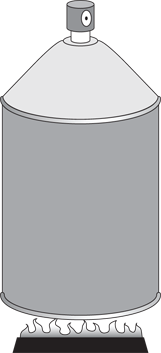
How much work does the fire do on the spray can? Look at the graph in Figure 17-4. In this case, the volume is constant, so Fs (force times distance) equals zero. No work is being done — the area under the graph is zero.
Figure 17-4: Because volume is constant in an isochoric process, no work is done.
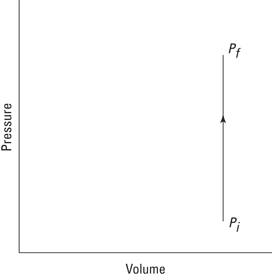
Here’s an example. The CEO of Acme Pressure Vessels approaches you and says, “We’re adding 16,000 joules of energy to 5 moles of ideal gas at constant volume, and we want to know how much the internal energy changes. Can you help?”
You get out your clipboard and explain. The work done by an ideal gas depends on the change in its volume: W = PΔV (see the earlier section “Staying constant: Isobaric, isochoric, isothermal, and adiabatic processes” for details on why). Because the volume change is zero in this case, the work done is zero.
The change in internal energy of an ideal gas is ΔU = Q – W. Because W is zero, the following is true:
ΔU = Q
You turn to the CEO and say, “You’ve added 16,000 joules of energy to an ideal gas at constant volume, so the change in the gas’s internal energy is exactly 16,000 joules.”
“What?” says the CEO. “That was too easy. We won’t pay.”
Handing the CEO a receipt, you say, “You already have. Thanks for your business.”
At constant temperature: Isothermal
In an isothermal system, the temperature remains constant as other quantities change. Look at the remarkable apparatus in Figure 17-5. It’s specially designed to keep the temperature of the enclosed gas constant, even as the piston rises. When you apply heat to this system, the piston rises or lowers slowly in such a way as to keep the product of pressure times volume constant. Because PV = nRT (see Chapter 14), the temperature stays constant as well. (Remember that n is the number of moles of gas that remains constant, and R is the gas constant.)
What does the work look like as the volume changes? Because PV = nRT, the relation between P and V is

You can see this equation graphed in Figure 17-6, which shows the work done as the shaded area underneath the curve. But what the heck is that area?

Figure 17-5: An isothermal system maintains a constant temperature amidst other changes.
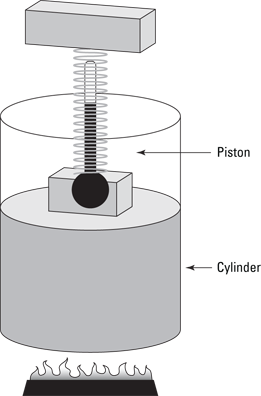
Figure 17-6: The area under the curve shows the work done in an isothermal process.
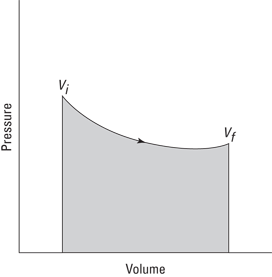
ΔU = Q – W
0 = Q – W
Q = W
If you immerse the cylinder you see in Figure 17-5 in a heat bath, what would happen? The heat, Q, would flow into the apparatus, and because the temperature of the gas stays constant, all that heat would become work done by the system.
Say that you have a mole of helium to play around with on a rainy day of temperature 20°C, and for fun you decide to expand it from Vi = 0.010 m3 to Vf = 0.020 m3. What’s the work done by the gas in the expansion? All you have to do is plug in the numbers:

The gas does 1,690 joules of work. The gas’s change in internal energy is 0 joules, as always in an isothermal process. And because Q = W, the heat added to the gas is also equal to 1,690 joules.
Here’s another example. Say that you’re given 2.0 moles of hydrogen gas at a temperature of 600 kelvins for your birthday. Expanding the gas from a volume of 0.05 cubic meters to 0.10 meters isothermally, you wonder how much work the gas does, so you get out your clipboard. The work done by an ideal gas during isothermal expansion is

Plugging in the numbers and doing the math gives you

So the gas does 6,900 joules of work during its expansion.
So what about the change in the internal energy of the gas? You know that the change in internal energy is ΔU = (3/2)nRΔT (see Chapter 16 for details). Therefore, because ΔT equals zero in an isothermal process, ΔU is zero as well. So the change in the internal energy of the gas is zero during the isothermal expansion.
At constant heat: Adiabatic
In an adiabatic process, no heat flows from or to the system. Take a look at Figure 17-7, which shows a cylinder surrounded by an insulating material. The insulation prevents heat from flowing into or out of the system, so any change in the system is adiabatic.
Examining the work done during an adiabatic process, you can say Q = 0, so ΔU (the change in internal energy) equals –W. Because the internal energy of an ideal gas is U = (3/2)nRT (see Chapter 14), the work done is the following:

where Tf represents the final temperature and Ti represents the initial temperature. So if the gas does work, that work comes from a change in temperature — if the temperature goes down, the gas does work on its surroundings.
You can see what a graph of pressure versus volume looks like for an adiabatic process in Figure 17-8. The adiabatic curve in this figure, called an adiabat, is different from the isothermal curves, called isotherms. The work done when the total heat in the system is constant is the shaded area under the curve.
Figure 17-7: An adiabatic system doesn’t allow heat to escape or enter.
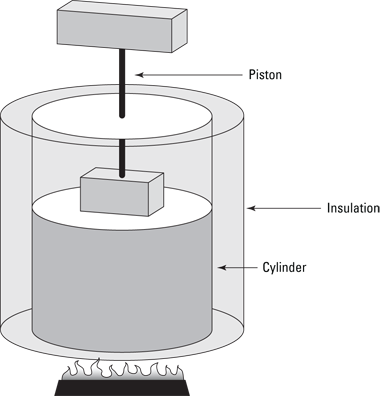
Figure 17-8: An adiabatic graph of pressure versus volume.
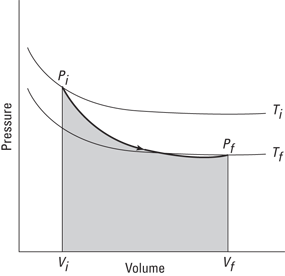
In adiabatic expansion or compression, you can relate the initial pressure and volume to the final pressure and volume this way:
PiViγ = PfVfγ
In this equation, γ is the ratio of the specific heat capacity of an ideal gas at constant pressure divided by the specific heat capacity of an ideal gas at constant volume (specific heat capacity is the measure of how much heat an object can hold; see Chapter 15):

How can you find those specific heat capacities? That’s coming up next.
Figuring out molar specific heat capacities
To figure out specific heat capacity, you need to relate heat, Q, and tempera-ture, T. You usually use the formula Q = cmΔT, where c represents specific heat capacity, m represents the mass, and ΔT represents the change in temperature.
For gases, however, it’s easier to talk in terms of molar specific heat capacity, which is given by C and whose units are joules/mole-kelvin (J/mol·K). With molar specific heat capacity, you use a number of moles, n, rather than the mass, m:
Q = CnΔT
To solve for C, you must account for two different quantities, CP (constant pressure) and CV (constant volume). Solved for Q, the first law of thermodynamics states that
Q = W + ΔU
So if you can get ΔU and W in terms of T, you’re set.
First consider heat at constant volume (QV). The work done (W) is PΔV, so at constant volume, no work is done; W = 0, so QV = ΔU. And ΔU, the change in internal energy of an ideal gas, is (3/2)nRΔT (see Chapter 16). Therefore, Q at constant volume is the following:

Now look at heat at constant pressure (QP). At constant pressure, work (W) equals PΔV. And because PV = nRT, you can represent the work as nRT: W = PΔV = nRΔT. At constant pressure, the change in energy, ΔU, is still (3/2)nRΔT, just as it is at constant volume. Therefore, here’s Q at constant pressure:

So how do you get the molar specific heat capacities from this? You’ve decided that Q = CnΔT, which relates the heat exchange, Q, to the temperature difference, ΔT, via the molar specific heat capacity, C. This equation holds true for the heat exchange at constant volume, QV, so you write

where CV is the specific heat capacity at constant volume. You already have an expression for QV, so you can substitute into the earlier equation:

Then you can divide both sides by nΔT to get the specific heat capacity at constant volume:

If you repeat this for the specific heat capacity at constant pressure, you get

Now you have the molar specific heat capacities of an ideal gas. The ratio you want, γ, is the ratio of these two equations:

PiVi5/3 = PfVf5/3
Finding a new pressure after an adiabatic change
Suppose you start with 1.0 liter of gas at a pressure of 1.0 atmosphere. After an adiabatic change (where no heat is gained or lost), you end up with 2.0 liters of gas. What would the new pressure, Pf, be? Putting Pf on one side of the equation gives you

Plug in the numbers and do the math:

The new pressure would be 0.31 atmospheres.
Building a bigger lab: An adiabatic-change practice problem
There you are, the world-famous physicist, on vacation in Antarctica. The head of a South Pole scientific team comes running up to you and asks for your help. “We’ve got a big problem,” the director says.
“Oh yes?” you ask.
“We put an explorer on the South Pole in a lab with vacuum chamber walls — the walls prevent any heat from being gained or lost to the environment, so he stays nice and cozy,” the director says. “The problem is we pressurized it too highly. It’s at 2 atmospheres and the scientist is very uncomfortable. We’d like to expand the volume of the lab so that it’s at 1 atmosphere inside.”
Always willing to come to the aid of a fellow scientist, you take out your clipboard. The specially constructed lab has vacuum chamber walls, so no heat is exchanged with the outside. Therefore, the expansion will be an adiabatic one, and this equation applies:

The scientists want to reduce the pressure from 2 atmospheres to 1 atmosphere, so

Solving the pressure-volume equation for the ratio of pressures, Pf/Pi, you get

If you raise both sides of this equation to the power 3/5, you get

Then if you invert the terms on both sides (this is the same as raising both sides to the power of –1), you get the following

Finally, multiply both sides by Vi to get

If you put in the value of the pressure ratio, you have

So Vf is about 1.5Vi. You turn to the director and say, “Expand the lab’s volume by 50 percent.”
“Thanks,” says the director. “Your usual fee?”
“No charge for a fellow scientist,” you say.
Flowing from Hot to Cold: The Second Law of Thermodynamics
The law is certainly borne out in everyday observation — when was the last time you noticed an object getting colder than its surroundings unless another object was doing some kind of work? You can force heat to flow away from an object when it would naturally flow into it if you do some work — as with refrigerators or air conditioners — but heat doesn’t go in that direction by itself.
Heat engines: Putting heat to work
You have many ways to turn heat into work. You may have a steam engine, for example, that has a boiler and a set of pistons, or you may have an atomic reactor that generates superheated steam that can turn a turbine.
Engines that rely on a heat source to do work are called heat engines; you can see the principle behind a heat engine in Figure 17-9. A heat source provides heat to the engine, which does work. The waste heat left over goes to a heat sink, which effectively has an infinite heat capacity, because it can take such a large amount of heat energy without changing temperature. The heat sink could be the surrounding air, or it could be a water-filled radiator, for example. As long as the heat sink is at a lower temperature than the heat source, the heat engine can do work — at least theoretically.
Figure 17-9: A heat engine turns heat into work.
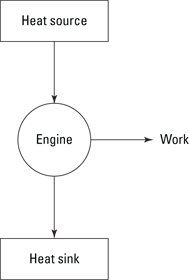
Evaluating heat’s work: Heat engine efficiency
Heat supplied by a heat source is given the symbol Qh (for the hot source), and heat sent to a heat sink is given the symbol Qc (for the cold heat sink). With some calculations, you can find the efficiency of a heat engine. The efficiency is the ratio of the work the engine does, W, to the input amount of heat — the fraction of the input heat that the engine converts to work:

If the engine converts all the input heat to work, the efficiency is 1.0. If no input heat is converted to work, the efficiency is 0.0. Often, the efficiency is given as a percentage, so you express these values as 100 percent and 0 percent.

Finding heat from a car engine
Say that you have a heat engine that’s 78.0 percent efficient and that produces 2.55 × 107 joules of energy. Perhaps this is the energy produced by the engine of a car from burning one tank of fuel. How much heat does the engine use, and how much does it reject? Well, you know that W = 2.55 × 107 joules and that

Solving for Qh gives you

The amount of input heat is 3.27 × 107 joules. So how much heat gets left over and sent into the heat sink, Qc? You know that Qh = W + Qc, and you can rearrange the problem to solve for Qc:
Qc = Qh – W
Plugging in the numbers gives you
Qc = Qh – W = (3.27 × 107 J) – (2.55 × 107 J) = 7.2 × 106 J
The amount of heat sent to the heat sink is 7.2 × 106 joules.
Finding heat from your race car
You’re at the race track, testing out your new physics racer. You’re proud of the car, which has 25 percent efficiency. Today, you estimate, it’s already produced 8,000 joules of work. Then you notice a mechanic about to put his hand on the radiator. “Don’t touch that,” you say. “It’s got to be hot.”
“How hot could it be?” the mechanic asks.
How hot indeed? The car gets rid of its excess heat through the radiator, you think. So how much heat did the car get rid of? Your car is 25 percent efficient and has done 8,000 joules of work, so the input heat is

Plugging in the numbers gives you:

Okay, the input heat was 32,000 joules. You know that the input heat equals the work done plus the output heat Qh = W + Qc, so the output heat is
Qc = Qh – W
The input heat was 32,000 joules and the engine did 8,000 joules of work, so plug in the numbers and solve:
Qc = Qh – W = 32,000 J – 8,000 J = 24,000 J
“How hot could the radiator be?” you ask the mechanic. “Twenty-four thousand joules hot, that’s how hot!”
“But how hot is that?” replies the mechanic? Indeed, if the radiator is 10 kilograms and it absorbs 24,000 joules of energy, how much does its temperature change? Well, if its specific heat capacity is 460 J/kg·K, then the change in temperature is the following:

A difference of 5.2 kelvins is the same as a difference of 5.2°C. “Oh, only five degrees? That’s fine,” says the mechanic. You wonder whether you should tell him that’s more than 40°F.
Limiting efficiency: Carnot says you can’t have it all
Given the amount of work a heat engine does and its efficiency, you can calculate how much heat goes in and how much comes out (along with a little help from the law of conservation of energy, which ties work, heat in, and heat out together). But why not create 100-percent efficient heat engines? Converting all the heat that goes into a heat engine into work would be nice, but the real world doesn’t work that way. Heat engines have some inevitable losses, such as through friction on the pistons in a steam engine.
Studying this problem, Sadi Carnot (a 19th-century engineer) came to the conclusion that the best you can do, effectively, is to use an engine that has no such losses. If the engine experiences no losses, the system will return to the state it was in before the process took place. This is called a reversible process. For example, if a heat engine loses energy overcoming friction, it doesn’t have a reversible process, because it doesn’t end up in the same state when the process is complete. You have the most efficient heat engine when the engine operates reversibly.
Carnot’s principle says that no nonreversible engine can be as efficient as a reversible engine and that all reversible engines that work between the same two temperatures have the same efficiency. Here’s the kicker: A perfectly reversible engine doesn’t exist, so Carnot came up with an ideal one.
Finding efficiency in Carnot’s engine
No real engine can operate reversibly, so Carnot imagined a kind of ideal, reversible engine. In the Carnot engine, the heat that comes from the heat source is supplied at a constant temperature Th. Meanwhile, the rejected heat goes into the heat sink, which is at a constant temperature Tc. Because the heat source and the heat sink are always at the same temperature, you can say that the ratio of the heat provided and rejected is the same as the ratio of those temperatures (expressed in kelvins):


This equation represents the maximum possible efficiency of a heat engine. You can’t do any better than that. And as the third law of thermodynamics states (see the final section in this chapter), you can’t reach absolute zero; therefore, Tc is never 0, so the efficiency is always 1 minus some number. You can never have a 100-percent efficient heat engine.
Using the equation for a Carnot engine
Applying the equation for maximum possible efficiency (Efficiency = 1 – Qc/Qh = 1 – Tc/Th) is easy. For example, say that you come up with a terrific new invention: a Carnot engine that uses a balloon to connect the ground (27°C) as a heat source to the air at 33,000 feet (about –25°C), which you use as the heat sink. What’s the maximum efficiency you can get for your heat engine? After converting temperatures to kelvins, plugging in the numbers gives you

Your Carnot engine can be no more than 17.3 percent efficient — not too impressive. On the other hand, assume you can use the surface of the sun (about 5,800 kelvins) as the heat source and interstellar space (about 3.40 kelvins) as the heat sink (such is the stuff science-fiction stories are made of). You’d have quite a different story:

You get a theoretical efficiency for your Carnot engine — 99.9 percent.
Here’s another example. You’re in Hawaii, taking a well-deserved vacation with other hard-working physicists. The summer has been hot, and as you lounge on the beach, you read an article about the energy crisis caused by all those whirring air conditioners. You put down the paper as the happy physicists bobbing in the surf call to you, saying you should come in for a dip.
“How warm is it?” you ask.
“Very,” they say, bobbing up and down. “About 300 kelvins.”
Hmm, you think. If you could create a Carnot engine and use the surface of the ocean as the input heat source (300 kelvins) and the bottom of the ocean (about 7°C, or 280 kelvins) as the heat sink, what would the efficiency of such an engine be? And how much input heat would you need to supply the entire energy needs of the United States for one year (about 1.0 × 1020 J)?
You know that Efficiency = 1 – (Tc/Th), so plug in the numbers and do the math to find the efficiency:

Hmm, 6.7 percent efficiency. So how much input heat would be needed to get 1.0 × 1020 joules out? You know that Efficiency = W/Qh, so

Plugging in the numbers and doing the math yields

How much would taking that heat out of the top meter of the Pacific Ocean change its temperature by? Assume that the top meter of the Pacific Ocean contains about 1.56 × 1014 cubic meters of water — that’s 1.56 × 1017 kilograms of water.
The heat gained or lost is tied to temperature change by Q = cmΔT, so the temperature change would be

Plugging in the numbers and doing the math gives you a temperature change of

So if your Carnot engine were connected from the top of the Pacific Ocean to the bottom and sucked all its heat out of the top meter of the surface water, it’d lower the temperature of that top meter of water by 4.5°C to supply all the energy needs of the United States.
Going against the flow with heat pumps
Usually, Carnot engines take heat from the hot reservoir (Qh), do work, and then dump the leftover heat in the cold reservoir (Qc). But what if you swapped the hot and cold reservoirs and actually did some work on the Carnot engine (instead of having it do work on you)? Then you could “pump heat uphill,” from the cold reservoir to the hot reservoir. You can do this if you connect the input of a Carnot engine to the cold reservoir and connect the exhaust to the hot reservoir.
Why on Earth would you want to move heat? Think about a cold room on an even colder day. If you connect a Carnot engine to the outside — which is colder than the inside — doing some work on the Carnot engine can drive heat into the room. This use of a Carnot engine is called a heat pump, because you put in work to drive heat uphill, from the cold reservoir to the hot one.
Why are heat pumps a good way to warm your house? Consider heating with electric heat instead. If you use enough electricity to add 1,000 joules to the heat inside your house, you have to pay for 1,000 joules of energy. But if you pump the heat from outside to inside, most of the heat comes from the cold reservoir, and you only have to provide the work needed to pump the heat into the hot reservoir.
A heat pump can be used to move heat in the other direction, too, to bring about cooling. In this case, mechanical work is used to pump heat from a source at a higher temperature to a lower temperature. Your refrigerator uses electrical energy to drive a compressor unit, which forms part of the refrigeration cycle.
Heating with less work
Operating heat pumps requires less work than the heat they transfer. For example, suppose you’re vacationing in your woodland cabin, which is at 20°C (that is, 293 kelvins — about 68°F). You want to pump some heat in from outside, which is at 10°C (283 kelvins — about 50°F). You decide you need about 4,000 joules of heat. How much work would you need to pump 4,000 joules into your house?
You unpack a Carnot engine and connect it to the outdoors so that it will use the outside (which is colder) as its hot reservoir and the inside of your cabin (which is warmer) as its cold reservoir. To get heat to flow uphill like that, you have to do work on the Carnot engine instead of having it do work on you.
So how much work do you need to pump 4,000 joules of heat inside? You can start from this equation:
Qh = W + Qc
Here, Qh is the heat dumped into the cabin and Qc is the heat taken from the outside. W is the amount of work you need to supply to the heat pump. You’re trying to solve for the work, so rearrange the equation:
W = Qh – Qc
For a Carnot engine, Qc/Qh = Tc/Th. Therefore, here’s the formula for the heat taken from the outside:

Now plug this value of Qc into the work equation (W = Qh – Qc) and simplify:

You want to get 4,000 joules of heat into the room, so Qh = 4,000 joules. Plugging in the heat and temperatures and doing the math gives you

So you’d need only 136 joules of work to pump 4,000 joules of heat in from the outside. See why heat pumps can be so attractive? If you were using electric heat, you’d have to pay for the full 4,000 joules.
However, as the temperature outside gets lower and lower, you have to do more work to pump heat indoors, because you have a bigger temperature difference to overcome. For example, what if the temperature outside were –20°C (that is, 253 kelvins, or –4°F)? In this case, how much work do you have to do on the Carnot engine to pump 4,000 joules of heat into the cabin?
You can use the same work equation you just derived:

Plugging in the numbers and doing the math gives you

So when the temperature outside is 10°C, you only need 136 joules to pump 4,000 joules of heat into your cabin. But when the outside temperature is –20°C, you need 546 joules to pump the same 4,000 joules. Notice, however, that in either case, you get 4,000 joules for a lot less than the whole 4,000 joules you’d have to pay for if you were using electric heat.
Checking a heat pump’s performance

The coefficient of performance tells you how much heat you get out of a heat pump per work you have to put in to it.
For something like electric heat, where you have to pay for all the heat you get, the coefficient of performance is 1. But for a heat pump, the coefficient can be a lot higher than 1, indicating that you get more heat out of the pump than the work you put in.
The coefficient of performance depends on the inside and outside temperatures. You can put the coefficient of performance into a form that makes its dependence on temperature explicit.
Because W = Qh – Qc, the coefficient of performance equation becomes

Or if you multiply both the numerator and denominator by 1/Qh, you can express this like so:

For a Carnot engine, Qc/Qh = Tc/Th, so you end up with

Suppose you’re pumping heat from 283 kelvins to 293 kelvins. You have a coefficient of performance of

So when the inside is at 293 kelvins and the outside at 283 kelvins, you pump 29 times as much energy as the work you do to make the heat transfer. Not bad.
Going Cold: The Third (And Absolute Last) Law of Thermodynamics
Absolute zero is the lower limit for the temperature of any system, and the third law of thermodynamics can be formulated in terms of this temperature. The third law of thermodynamics is pretty straightforward — it just says that you can’t reach absolute zero (0 kelvins, or about –273.15°C) through any process that uses a finite number of steps. In other words, you can’t get down to absolute zero at all. Each step in the process of lowering an object’s temperature to absolute zero can get the temperature a little closer, but you can’t get all the way there.


